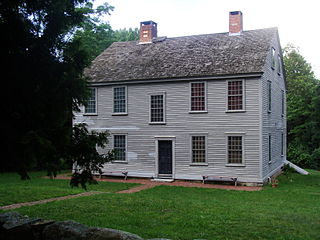
The Eleazer Arnold House is a historic house built for Eleazer Arnold in about 1693, and located in the Great Road Historic District at Lincoln, Rhode Island. It is now a National Historic Landmark owned by Historic New England, and open to the public on weekends.

The Governor Henry Lippitt House is a historic house museum at 199 Hope Street on the East Side of Providence, Rhode Island. A National Historic Landmark, it is one of the finest Italianate mansion houses in the state, and considered one of the best-preserved examples of Victorian-era houses in the United States. It is notable for its association with Henry Lippitt (1818–91), a wealthy textile magnate who was the 33rd Governor of Rhode Island. The house is owned by Preserve Rhode Island, and is open to the public for tours seasonally or by appointment.

The Clemence–Irons House is a historic house located in Johnston, Rhode Island. It was built by Richard Clemence in 1691 and is a rare surviving example of a "stone ender", a building type first developed in the western part of England and common in colonial Rhode Island. The house is listed on the National Register of Historic Places, and is a historic house museum owned and operated by Historic New England. It is open Saturdays between June and mid-October.

The Corbit–Sharp House is a historic house museum located at 118 Main Street in Odessa, Delaware. Built in 1772–74, it is one of the finest examples of a brick Georgian house in the Mid-Atlantic states. It was declared a National Historic Landmark in 1967, and is included in the Odessa Historic District. It has been a museum, under different ownerships, since 1940.

The John Brown House is the first mansion built in Providence, Rhode Island, located at 52 Power Street on College Hill where it borders the campus of Brown University. The house is named after the original owner, one of the early benefactors of the university, merchant, statesman, and slave trader John Brown. It was declared a National Historic Landmark in 1968. John Quincy Adams considered it "the most magnificent and elegant private mansion that I have ever seen on this continent."
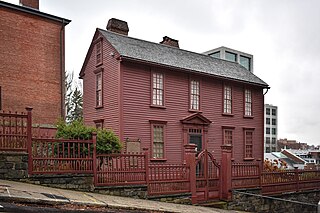
The Governor Stephen Hopkins House is a museum and National Historic Landmark at 15 Hopkins Street in Providence, Rhode Island. It was the home of Stephen Hopkins, a governor of the Colony of Rhode Island and Providence Plantations and a signer of the Declaration of Independence.
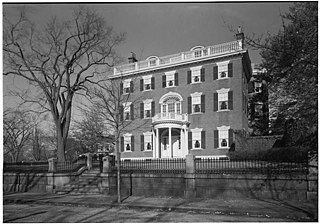
The Thomas P. Ives House is a National Historic Landmark at 66 Power Street in the College Hill in Providence, Rhode Island. Built in 1803–06, this brick house is an extremely well-preserved and little-altered example of Adamesque-Federal style. The house was built by Caleb Ormsbee, a Providence master builder, for Thomas Poynton Ives, a wealthy merchant. Although two of its principal chambers were redecorated in the 1870s, these alterations were reversed in the 1950s. The house was in Ives family hands for more than 150 years. It was designated a National Historic Landmark on December 30, 1970.

The Joseph Reynolds House is a historic house at 956 Hope Street in Bristol, Rhode Island, United States, built c. 1698–1700. The three-story wood-frame house is one of the oldest buildings in Bristol and the oldest known three-story building in Rhode Island. It exhibits distinctive, well-preserved First Period features not found in other houses, despite an extensive history of adaptive alterations. It is further significant for its use by the Marquis de Lafayette as headquarters during the American Revolutionary War. It was designated a National Historic Landmark in 1983.

The Corliss–Carrington House is a National Historic Landmark house at 66 Williams Street in the College Hill neighborhood of Providence, Rhode Island. Built in 1812, it is significant as a high-quality and well-preserved example of an Adamesque-Federal style town house.

The Clement Weaver–Daniel Howland House is a historic stone-ender timber frame house built in 1679. This rare example of primitive 17th-century architecture is located at 125 Howland Road in East Greenwich, Rhode Island. It is the oldest documented dwelling house in Kent County and the second oldest home in Rhode Island.

Bristol County Jail is a historic jail at 48 Court Street in Bristol, Rhode Island, and home to the Bristol Historical and Preservation Society.

The Captain Stephen Olney House is a historic site in North Providence, Rhode Island. It is a 2+1⁄2-story wood-frame structure, five bays wide, with a pair of interior chimneys. The principal exterior decoration is in the front door surround, which features pilasters supporting an entablature and gable pediment. The house was built in 1802 by Stephen Olney, a veteran of the American Revolutionary War, on what was then a large farm. His descendants enlarged the house in the 1840s, adding an ell to the south.

The Joseph Haile House is an historic house in the College Hill neighborhood of Providence, Rhode Island. It is a 3+1⁄2-story brick structure, appearing taller than that due to its hillside location and raised basement. It is a well-preserved example of Federal styling, which underwent a careful restoration in the 1930s by George Warren Gardner, who filled the house with early American furniture. The Gardners bequested the property to Brown University, which uses it to house visiting dignitaries.
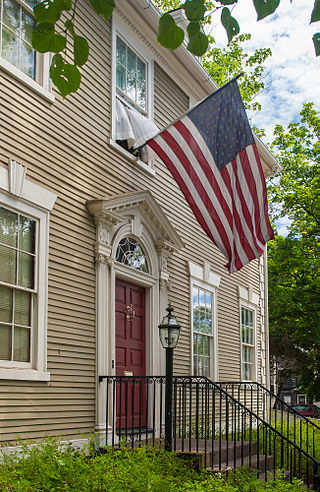
The Nathaniel Pearce House is an historic house at 305 Brook Street in Providence, Rhode Island. This Early Republican house is an "archetype of domestic design of its period". It was built in 1801 at 41 George Street on Brown's Main Green facing University Hall, where it enjoyed a view of Narragansett Bay. Nathaniel Pearce, a ship-master and ship-owner, purchased it circa 1780, doubled its size with a central hallway and new ornamental entrance and re-oriented to George Street in 1800. By 1888 it was owned by the Goddard family, who sold the George Street land to Brown University. Conditions of the sale required the house be either demolished or moved. John J. DeWolf bought the house and moved it to Brook Street in that year. In 1915, his nephew Halsey DeWolf, MD inherited the house and commissioned an expansion and colonial revival enhancements by his wife's cousin, architect Wallis E. Howe of Clarke & Howe. Landscape architects Searle & Searle refurbished the rear garden in the mid-1990s.

The Joseph and William Russell House is a historic house at 118 North Main Street in the College Hill area of Providence, Rhode Island. It is a brick Georgian house built in 1772. Its original interior woodwork has been removed and distributed among museums around the United States.

The Tabor-Wing House is located on NY 22 in Dover Plains, New York, United States. It is a frame house built in 1810 by a prominent family in the area, relatively intact today.

The William Ruth Mansion House is a historic house in Leipsic, Delaware. Originally built for William Ruth, a merchant and trustee of the first free school in Delaware, the house was listed in the National Register of Historic Places on April 11, 1973.

The Cushing and Hannah Prince House is a historic house at 189 Greely Road in Yarmouth, Maine. Built in 1785 and substantially remodeled about 1830, it is a fine local example of a rural Federal period farmhouse with Greek Revival features. It was listed on the National Register of Historic Places in 1999.
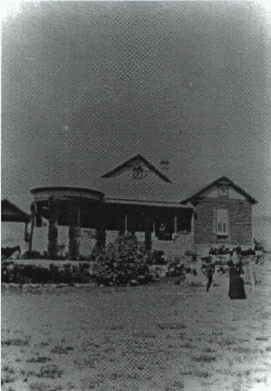
The Henry M. and Annie V. Trueheart House is a residence of historic significance located in the town of Fort Davis, the seat and largest town of Jeff Davis County in the U.S. state of Texas. The house was built in 1898 and, along with the surrounding property, was added to the National Register of Historic Places (NRHP) in 1996. The Trueheart House has also been distinguished as a Recorded Texas Historic Landmark (RTHL) since 1964.



















